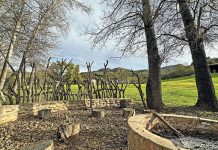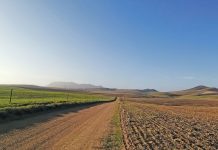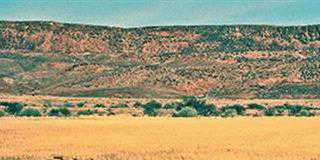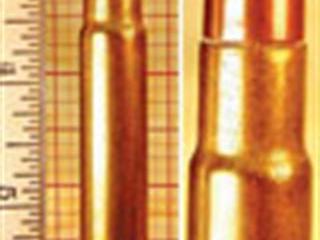
Terminal ballistics – a sub field of ballistics – is the study of what happens to the bullet and the target from the time the bullet impacts the target to the moment the projectile either stops within the target, or exits it. Sometimes the bullet explodes on impact, as when administering a head shot to animals such as baboons, vervet monkeys or jackal.
At other times, deep penetration without deformation is needed, as in a frontal brain shot to a bull elephant. Between these extremes there are times when penetration to different depths and wound channels of different sizes are needed. No single bullet can meet all these requirements. The ‘temporary wound channel’ and various other theories were invented to compare the effects of gunshot wounds on people. These theories were propounded and popularised by shooting into a substance called ballistic clay that forms a so-called ‘temporary’ cavity when hit by a bullet.
This is of no value to the hunter, because ballistic clay does not shoot back, charge, gore, trample, scratch or bite. It does not raid crops of livestock, nor is it edible. The bullet arrives at the target carrying kinetic energy, some of which is transferred on impact. Shooting a buffalo bull through the stomach, or too high through the neck with even a 460 Weatherby Magnum, which probably produces the most kinetic energy possible in a hand-held weapon, proves that an animal is not killed by energy alone.
Energy launches the bullet and carries it to where it must destroy a vital organ. The destruction of vital organs is what kills.
The other force that helps drive the bullet home is momentum. The transfer of kinetic energy in the bullet to the substance it strikes, deforms an expanding-type bullet, reducing its penetrating ability but enlarging the wound channel. Penetration depth is inversely proportional to the size of the wound channel. So – what will it be? A small but deep channel, or a big but shallower channel?
The former requires a strongly constructed bullet, the latter, one less so. Both should hit the target at the same impact velocity, bearing in mind that a bullet starts losing velocity the moment it exits the muzzle. It is possible to use the same bullet for both requirements, loading it to a higher muzzle velocity (and therefore higher impact velocity and energy for more bullet expansion) for a larger wound but shallower, or loading it to lower muzzle velocity and therefore lower energy for less bullet expansion, giving a smaller wound channel but deeper penetration.
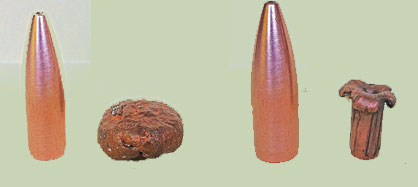
Kinetic energy
We accept that a significant part of the kinetic energy arriving with the bullet is lost in expanding it. A useful formula for bullet energy is:
E = mv2 /450240
Here E is energy in foot-pounds, m is mass in grains and v is impact velocity in feet per second. The constant 450240 takes care of conversions and the role of gravity. It is accurate enough to assume that half the energy is used to expand the bullet. Depending on the specific bullet, there may be some weight loss, which will have to be estimated, based on previous experience with that bullet’s performance.
The momentum – M – left to drive the bullet to the vital organ is now represented by M = rm.rv, where rm is the retained weight of the bullet after expansion (to be converted first to pounds by dividing by 7 000) and rv is the remaining velocity, having halved the calculated E and applying m in the formula to arrive at the new, admittedly theoretical, v, and renaming it rv. The greater the momentum, the deeper the penetration.
We could calculate the figures but we cannot predict the depth of penetration, as the penetration of the expanded bullet will not be in a uniform medium, or in one that can be compared to another, even in a very similar shot. It is, however, useful to compare the values of different bullets and/or different velocities.
When doing so, compute and compare values sufficiently far from the extremes – a thin-jacketed .224 bullet hitting an elephant’s forehead at 4 000ft/s will probably not penetrate the skin more than a millimetre or two, and a tough-jacketed .458 soft-nosed bullet at 2 000ft/s going through a dove will not receive enough resistance to expand the bullet. Nonsensical results indicate that you are working in the extremes.
Wound channel
It is practically impossible to compare two wound channels, and therefore to predict any one with accuracy. There are too many variables involved where the target is a game animal. Rather narrow things down to the best possible choice of bullet and velocity for the job on hand. Then bring the three most important factors – bullet placement, bullet placement and bullet placement – into play.
A perennial argument in hunting is whether or not the bullet should penetrate right through the animal. Both sides have valid points. The clincher? More animals are wounded through under-penetration than through over-penetration. This, and the fact that the hunter is responsible for any damage caused by a still-flying bullet, reminds him to determine what is behind to stop his bullet before he shoots.
An interesting practical exercise is to compute the momentum remaining after expansion of a 150g .270 bullet at 100m with that of a 150g .308 bullet at the same range, using realistic estimates of weight loss. It may be interesting! Comparing a 90g bullet from a .243 with a 180g bullet from a .308 may prove equally enlightening, especially at a realistic weight retention estimate.
Contact Field Sports writers on 083 235 4775 or [email protected]


